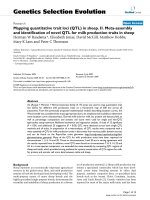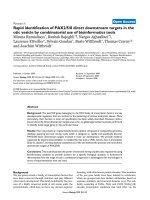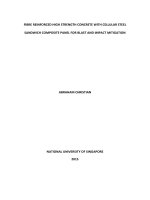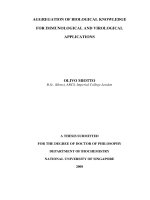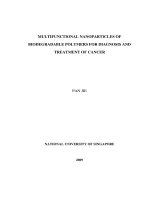Identification of resistant sources for blast and rust in foxtail millet incited by Pyricularia Setariae and Uromyces Setariae-Italica
Bạn đang xem bản rút gọn của tài liệu. Xem và tải ngay bản đầy đủ của tài liệu tại đây (349.38 KB, 5 trang )
����������������������������������������������������������������������������������������������������������������������������������������������������������������������������������������������������������������������������������������������������������������������������������������������������������������������������������������������������������������������������������������������������������������������������������������������������������������������������������������������������������������������������������������������������������������������������������������������������������������������������������������������������������������������������������������������������������������������������������������������������������������������������������������������������������������������������������������������������������������������������������������������������������������������������������������������������������������������������������������������������������������������������������������������������������������������������������������������������������������������������������������������������������������������������������������������������������������������������������������������������������������������������������������������������������������������������������������������������������������������������������������������������������������������������������������������������������������������������������������������������������������������������������������������������������������������������������������������������������������������������������������������������������������������������������������������������������������������������������������������������������������������������������������������������������������������������������������������������������������������������������������������������������������������������������������������������������������������������������������������������������������������������������������������������������������������������������������������������������������������������������������������������������������������������������������������������������������������������������������������������������������������������������������������������������������������������������������������������������������������������������������������������������������������������������������������������������������������������������������������������������������������������������������������������������������������������������������������������������������������������������������������������������������������������������������������������������������������������������������������������������������������������������������������������������������������������������������������������������������������������������������������������������������������������������������������������������������������������������������������������������������������������������������������������������������������������������������������������������������������������������������������������������������������������������������������������������������������������������������������������������������������������������������������������������������������������������������������������������������������������������������������������������������������������������������������������������������������������������������������������������������������������������������������������������������������������������������������������������������������������������������������������������������������������������������������������������������������������������������������������������������������������������������������������������������������������������������������������������������������������������������������������������������������������������������������������������������������������������������������������������������������������������������������������������������������������������������������������������������������������������������������������������������������������������������������������������������������������������������������������������������).
Application of pesticides is not common in
small millets therefore each season crops
suffer from serious losses, especially due to
blast and rust in foxtail millet. Thus
development of genotypes resistant to these
diseases is essential considering the poor
purchasing power of rainfed farmers and safer
ecology. Therefore, an attempt has been made
to identify the suitable foxtail millet
genotypes, which can be exploited for
In order to find out resistant sources against
blast disease caused by Pyricularia setariae
and rust disease caused by Uromyces setariaeitalica, field experiment was conducted with
twelve foxtail millet genotypes were grown in
a sandwich method with three replications
during kharif 2016 under natural epiphytotic
conditions at research farm of Centre of
Excellence in Millets, Athiyandal, where the
severity of these diseases remain very high
during the cropping season. The recommended
agronomical practices were adopted for better
crop growth. Each entry was sown in two
rows of 3m length and plot size of 3 m x 2.25
m; keeping the 20 cm row to row and 10cm
plant to plant distance. Every entry was
sandwiched by a local variety [CO(Te)7] as
check (Plate 3). Five randomly selected plants
were selected from each genotype/replication
for recording the observations. Observations
were recorded at panicle emergence stage for
leaf blast and rust symptoms on leaves. The
resistance or otherwise of the test genotypes to
blast and rust diseases was assessed using 1-9
rating scale (Proceedings of 27th Annual
Group Meeting of AICRP on Small Millets,
2016) as follows,
SES for blast
Score
1
2
3
4
5
6
7
8
9
Description
Small brown specks of pinhead size without sporulating centre.
Small roundish to slightly elongated, necrotic grey spots, about 1-2 mm in diameter with
a distinct brown margin and lesions are mostly found on the lower leaves.
Lesion type is the same as in scale 2, but significant numbers of lesions are on the upper
leaves.
Typical sporulating blast lesions, 3 mm or longer, infecting less than 2% o the leaf area.
Typical blast lesions infection 2-10% of the leaf area.
Blast lesions infecting 11-25% leaf area.
Blast lesions infecting 26-50% leaf area.
Blast lesions infecting 51-75% leaf area.
More than 75% leaf area affected
1797
Reaction
R
MR
MR
MS
MS
S
S
HS
HS
Int.J.Curr.Microbiol.App.Sci (2019) 8(3): 1796-1800
Incidence of rust: SES Scale
Score
0-1
1.1-3
3.1-5
5.1-7
7.1-9
Description
Pinhead flecks with no sporulation
Small scattered erumpent pustules with little sporulation
Clear many erumpent pustules containing numerous spores
Many coalescing pustules covering < 50% leaves
Many coalescing pustules covering most (>50%) leaves
Results and Discussion
Typical leaf blast symptoms were observed on
the leaf lamina (Plate 1). Initially, small
yellowish dot appeared that within 2-3 days
turned circular to oval with a grayish centre
surrounded by brown margin. In severe form,
lesions coalesced with tearing off of infected
portion. Under high relative humidity, central
grayish region became brownish colour
indicating sporulation of the causal fungus.
Similar symptoms were reported by
Ramakrishnan (1948) and Sharma et al.,
(2014). The lower leaves were severely
affected than top young leaves with no
symptoms observed on leaf sheath, nodes,
peduncle and panicle. Symptoms of blast and
Reaction
R
MR
MS
S
HS
rust disease (Plate 2) were observed and
grades of disease severity were recorded. The
data present in the table 1 revealed that a total
of twelve foxtail millet genotypes were
evaluated against blast and rust diseases, out
of which SiA 3205 and SiA 3164 genotype
and Check CO (Te)7 could exhibit Highly
resistant reaction. Among the twelve
genotypes screened against blat and rust
diseases, maximum grade of disease severity
was recorded in SiA 3163 (4 and 7.67 grade
respectively) and the minimum percentage of
disease severity was recorded in SiA 3164
(1.00 and 0.67 grade respectively). Among the
twelve genotypes, SiA 3164 and SiA 3205
were evaluated as resistant genotypes.
Table.1 Grades of blast and rust diseases of foxtail millet
S.
No
Entry No
1
2
3
4
5
6
7
8
9
10
11
12
13
SiA 3205
RFM-68
DHFTMV 2-5
SiA 3163
DHFT 5-6
SiA 326
H-46
SiA 3164
SiA 3159
SiA 3156
SiA 3179
DHFT 77-3
Check CO (Te) 7
Leaf blast (G)
Replications
I
II
III
1.00
1.00
1.00
4.00
3.00
3.00
3.00
2.00
2.00
5.00
3.00
4.00
1.00
3.00
3.00
2.00
3.00
2.00
2.00
3.00
2.00
1.00
1.00
1.00
2.00
2.00
3.00
5.00
2.00
3.00
3.00
3.00
1.00
3.00
3.00
3.00
2.00
1.00
2.00
1798
Rust (G)
Mean
1.00
3.33
2.33
4.00
2.33
2.33
2.33
1.00
2.33
3.33
2.33
3.00
1.67
Replications
I
II
III
1.00
1.00
1.00
5.00
5.00
3.00
5.00
3.00
3.00
7.00
9.00
7.00
1.00
3.00
3.00
1.00
1.00
1.00
1.00
1.00
1.00
0.00
1.00
1.00
5.00
5.00
7.00
7.00
7.00
5.00
3.00
3.00
3.00
3.00
3.00
3.00
1.00
1.00
1.00
Mean
1.00
4.33
3.67
7.67
2.33
1.00
1.00
0.67
5.67
6.33
3.00
3.00
1.00
Int.J.Curr.Microbiol.App.Sci (2019) 8(3): 1796-1800
Plate.1 Typical leaf blast symptoms on the leaf lamina
Plate.2&3 Typical rust symptoms on the leaf lamina & Field view of screening trial at Centre of
Excellence in Millets, Athiyandal
These genotypes could be considered a
potential source for disease resistance against
the blast and rust of foxtail millet and could
be used in breeding program for development
of blast and rust resistant foxtail millet
variety. Jain (2000) also found three resistant
foxtail millet cultivars out of thirteen cultivars
screened for resistance against P. setariae.
Likewise, Sharma et al., (2014) also found
that out of 154 accessions of foxtail millet
screened for blast resistance under field
conditions, 34 were resistant and 96 were
moderately resistant during 2009; whereas, in
2010, number of accessions in the resistant
and moderately resistant categories was 46
and 65 respectively.
References
Anonymous, Proceedings of 27th Annual
Group Meeting of AICRP on Small
Millets, 2016. Held at Regional
Agricultural Research Station, Tirupati,
April 17-19, 2016.
Crop and Season report 2015–16. Published
by Department of Economics and
Statistics, Chennai, Government of
Tamil Nadu. pp125.
Jain, A. K. 2000. Multiple disease resistance
in foxtail millet. Ann. Pl. Prot.
Sci.,8(2):pp268-270.
Kawakami, T. 1902. On the blast disease of
rice. J. Sapporo Agric. Soc.,3: pp1-3.
1799
Int.J.Curr.Microbiol.App.Sci (2019) 8(3): 1796-1800
MCRae, W. 1920. Detailed administration
report of the Government Mycologist
for the year 1919-20.
Nagaraja, A., J. Kumar, A.K. Jain, Y.
Narasimhadu, T. Raghuchander, B.
Kumar and B.H. Gowda. 2007.
Compendium of small millets diseases.
Project Coordinator Cell, All India
Coordinated
Small
Millets
Improvement Project, UAS, GKVK
Campus, Bengaluru. pp80.
Ramakrishnan. 1948. Studies on the
morphology, physiology and parasitism
of the genus Pyricularia in Madras,
Proceedings of the Indian Academy of
Sciences Section B, 27(6): pp174-193.
Reddy, V.G., H.D. Upadhyaya and C.L.L.
Gowda. 2006. Characterization of
world’s foxtail millet germplasm
collections for morphological traits.
Internet
Resource: />cropimprovement/v2i1/v2i1characteriza
tion.pdf.
Sharma, R., A. G. Girish, H. D. Upadhyaya,
P. Humayun, T. K. Babu, V. P. Rao and
R. P. Thakur. 2014. Identification of
blast resistance in a core collection of
foxtail millet germplasm. Plant Disease,
98:pp519-524.
How to cite this article:
Rajesh, M., A. Sudha, A. Nirmalakumari and Parasuraman, P. 2019. Identification of Resistant
Sources for Blast and Rust in Foxtail Millet Incited by Pyricularia setariae and Uromyces
setariae-Italica. Int.J.Curr.Microbiol.App.Sci. 8(03): 1796-1800.
doi: />
1800



